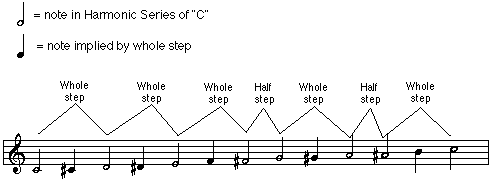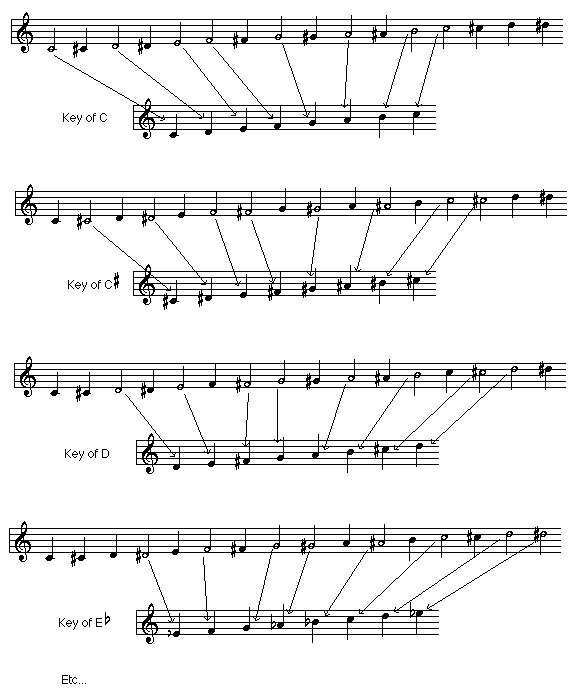Intonation III
| Previous article | Next article |
|
In Intonation I I showed how the Harmonic Series implies the 12 tones of our chromatic scale, as well as the discrepancies between the distance between these tones which leads to discrepancies in intonation. Intonation II described the main temperaments and their corresponding musical periods. In this article, I'll make the case for equal temperament as the best compromize for modern music. Scales RevisitedAs I described in Intonation II, the Harmonic Series creates a seven-tone diatonic scale. This scale hints tantalizingly at a 12-tone chromatic scale by offering two sizes of steps, one roughtly twice the size of the other. By simply filling in a tone halfway between the whole steps, the 12-tone chromatic scale appears.
Once we have a 12-tone chromatic scale, we can build a diatonic 7-tone scale from any of those 12 tones by skipping 5 of the 12 to produce the correct sequence of whole- and half-steps. (Note that the Major scale, long ago established as the "home base" for diatonic harmony, has a different pattern of whole- and half-steps than that produced by the Harmonic Series. The reasons for this are way, way beyond the scope of this article.) This produces our familiar system of 12 diatonic key centers. This system is so entrenched in our concept of harmony that the pattern of whole-and half-steps is built into the staff; there is no chromatic step between E and F or between B and C.
Diatonic harmony creates the powerful sense of tonality by generating the I-IV-V triadic harmony which anchors practically all Western music. Chromatic harmony offers the interest of contrasting tonalities against one another. This system of 7-tones within 12-tones powers virtually every kind of music with any hamonic or melodic content the world over - even Japanese and Indian musics with their microtonal inflections are temperamental variations on this 12-tone system. Moreover, all of the emotional power of harmony to bring a melody to life springs from this structure. It's hard to overstate this point: Jazz, Country, Classical, Folk, Rock, Pop, Funk, Ambient, Klezmer, Salsa, World, you name it - all of these styles rely on their own characteristic uses of 12-tone harmony for their very existance. The Illusion of the 12-tone Chromatic ScaleOK, so 12 tones are good. But when we filled in the spaces between the whole-steps we assumed that they were all the same size, and all twice the size of a half-step. Unfortunately, the Harmonic Series didn't provide us with quite that tidy a package. In fact, the implication of 12 half-steps is a mere mathematical accident! As I showed in Intonation II, some of the steps generated from the Harmonic Series are off by as much as 22 cents - almost a quarter of a half-step. But still, to our ears the implication of 12 tones is real. This has motivated folks down throughout history to devise the various temperamants which I described in Intonation II. However, only one of these temperaments works for all 12 keys, by virtue of making all 12 half-steps exactly the same size: Equal Temperament. The Case for Equal TemperamentEqual Temperament has had a bad rap since its inception. Baron von Helmholtz, the father of Acoustics as a science, so preferred Just Temperament that he declared that string and vocal groups, performing without reference to a tempered instrument, would automatically play in Just intervals. Modern electronic analysis has proved this false. Performers actually tend towards Pythagorean thirds - even sharper than Equal Temperament thirds! The fact is, intonation is part of the expressive palette of most instruments. Wind, string and vocal musicians adjust the intonation of each note, and not necessarily to achieve perfect consonance. Guitarists in particular often bend strings for pitch inflection. This is part of the essential tension and release of musical flow. All musicians, regardless of what instrument they play of sing through, must play their instrument in tune, and use intonation as an expressive tool. The fact is, Equal Temperament is not just a necessary compromise, it's a very reasonable one in exchange for the rich palette of harmonic expression it provides by making the 12-tone system practical. Pianos, correctly intonated guitars, and any other instruments playing with them conform to it, which accounts for the vast majority of recorded music... I'm talking practically all of the music you've ever heard! I often wonder how many of those folks who talk knowingly about the superiority of earlier temperament systems have actually heard music played with those temperaments! But most importantly for guitarists and luthiers, the spacing of frets on the guitar fretboard is Equal tempered. The only way to achieve another temperament is to make a special "broken Fret" fretboard for each key you wish to use! This may be appropriate for performance of some early music, although not strictly accurate since such fretboards weren't used at the time. In IntonationIV, I'll apply our discussion of temperament and intonation to the guitar, discuss a few popular methods of intonating our instrument, and show why pianos and guitars can't ever really be in tune with one another. Meanwhile, I'll look for your suggestions and questions in my mailbox... For an in-depth discussion of temperaments and other topics in acoustics, read "The Acoustic Foundations of Music" by John Backus (W. W. Norton & Co). This book is the source of much of the information for this article series. |
| Previous article | Next article |

